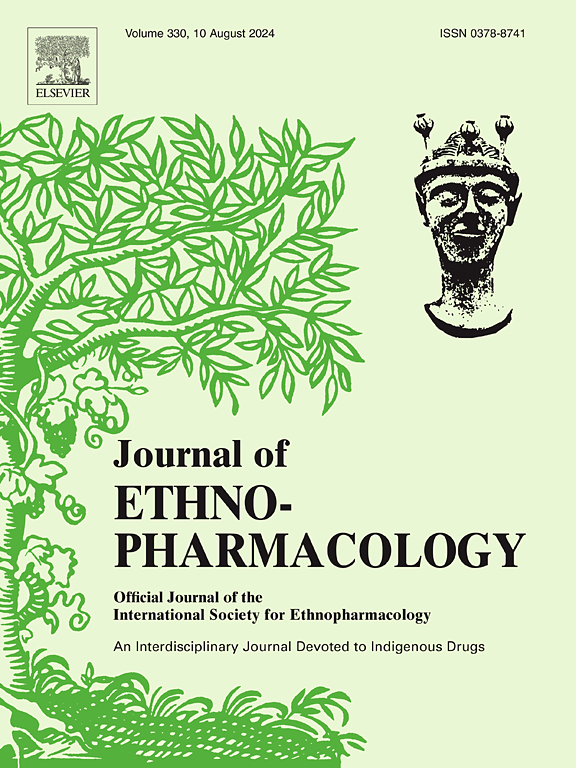Phytochemical characterization and pharmacological mechanisms of Huazhuo Sanjie Chubi Decoction in treating gouty arthritis: A multivariant approach
IF 4.8
2区 医学
Q1 CHEMISTRY, MEDICINAL
引用次数: 0
Abstract
Ethnopharmacological relevance
Huazhuo Sanjie Chubi Decoction (HSCD), a Chinese herbal formula, is traditionally used for the treatment of spleen deficiency with dampness accumulation and is commonly used to treat gouty arthritis (GA). However, the potential active compounds and mechanisms of HSCD remain unclear.
Aim of the study
To elucidate the key bioactive compounds and pharmacological mechanisms of HSCD in treating GA.
Materials and methods
The chemical compounds in HSCD were qualitatively and quantitatively analyzed using ultraperformance liquid chromatography tandem mass spectrometry (UPLC-MS/MS). Network pharmacology and molecular docking were employed to identify key active compounds and associated molecular pathways. Monosodium urate (MSU)-induced RAW264.7 macrophages and GA rat model were used to explore the potential therapeutic effects and mechanisms of HSCD in treating GA.
Results
UPLC-MS/MS identified 184 compounds in HSCD, with 28 key compounds quantified. Network pharmacology revealed that verbenalin, limonin, and quercitrin are strongly associated with the molecular mechanisms of HSCD in treating GA via the PI3K-AKT signaling pathway. These compounds exhibited strong binding affinity to PI3K and AKT proteins. In RAW264.7 cells, HSCD and the three identified compounds dose-dependently reduced inflammation by inhibiting nucleotide-binding oligomerization domain-like receptor protein 3 (NLRP3), cyclooxygenase-2 (COX-2) and inducible nitric oxide synthase (iNOS). They also downregulated both the PI3K-AKT and apoptosis signaling pathways. In rats, HSCD exerted therapeutic effects against acute GA by alleviating swelling and pathological damage to the ankle joints. Moreover, the molecular mechanisms in vivo were confirmed to be associated with the PI3K-AKT and apoptosis signaling pathways.
Conclusion
This study employed a multivariant approach to demonstrate the main bioactive compounds and molecular mechanisms of HSCD in treating GA, thereby supporting its traditional use.

化浊散结除痹汤治疗痛风性关节炎的植物化学特征及药理机制:多变量研究。
民族药理学相关性:化浊散戒除痹汤(HSCD)是一种中药方剂,传统上用于治疗脾虚湿积,常用于治疗痛风性关节炎(GA)。然而,HSCD的潜在活性化合物和机制尚不清楚。研究目的:阐明HSCD治疗GA的主要生物活性成分及其作用机制。材料和方法:采用超高效液相色谱-串联质谱(UPLC-MS/MS)对HSCD中的化合物进行定性和定量分析。利用网络药理学和分子对接技术鉴定关键活性化合物和相关分子通路。采用单钠尿酸(MSU)诱导的RAW264.7巨噬细胞和GA大鼠模型,探讨HSCD治疗GA的潜在治疗作用和机制。结果:hplc -MS/MS鉴定出HSCD中184个化合物,其中28个关键化合物得到定量分析。网络药理学研究显示马鞭草苷、柠檬苦素和槲皮苷通过PI3K-AKT信号通路与HSCD治疗GA的分子机制密切相关。这些化合物与PI3K和AKT蛋白具有很强的结合亲和力。在RAW264.7细胞中,HSCD和三种鉴定的化合物通过抑制核苷酸结合寡聚结构域样受体蛋白3 (NLRP3)、环氧合酶-2 (COX-2)和诱导型一氧化氮合酶(iNOS),剂量依赖性地减轻炎症。它们还下调了PI3K-AKT和凋亡信号通路。在大鼠中,HSCD通过减轻踝关节肿胀和病理损伤对急性GA有治疗作用。此外,体内的分子机制被证实与PI3K-AKT和凋亡信号通路有关。结论:本研究采用多变异方法证实了HSCD治疗GA的主要生物活性化合物和分子机制,从而支持了其传统应用。
本文章由计算机程序翻译,如有差异,请以英文原文为准。
求助全文
约1分钟内获得全文
求助全文
来源期刊

Journal of ethnopharmacology
医学-全科医学与补充医学
CiteScore
10.30
自引率
5.60%
发文量
967
审稿时长
77 days
期刊介绍:
The Journal of Ethnopharmacology is dedicated to the exchange of information and understandings about people''s use of plants, fungi, animals, microorganisms and minerals and their biological and pharmacological effects based on the principles established through international conventions. Early people confronted with illness and disease, discovered a wealth of useful therapeutic agents in the plant and animal kingdoms. The empirical knowledge of these medicinal substances and their toxic potential was passed on by oral tradition and sometimes recorded in herbals and other texts on materia medica. Many valuable drugs of today (e.g., atropine, ephedrine, tubocurarine, digoxin, reserpine) came into use through the study of indigenous remedies. Chemists continue to use plant-derived drugs (e.g., morphine, taxol, physostigmine, quinidine, emetine) as prototypes in their attempts to develop more effective and less toxic medicinals.
 求助内容:
求助内容: 应助结果提醒方式:
应助结果提醒方式:


